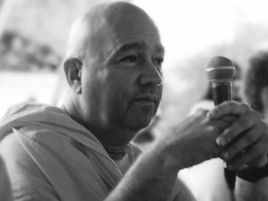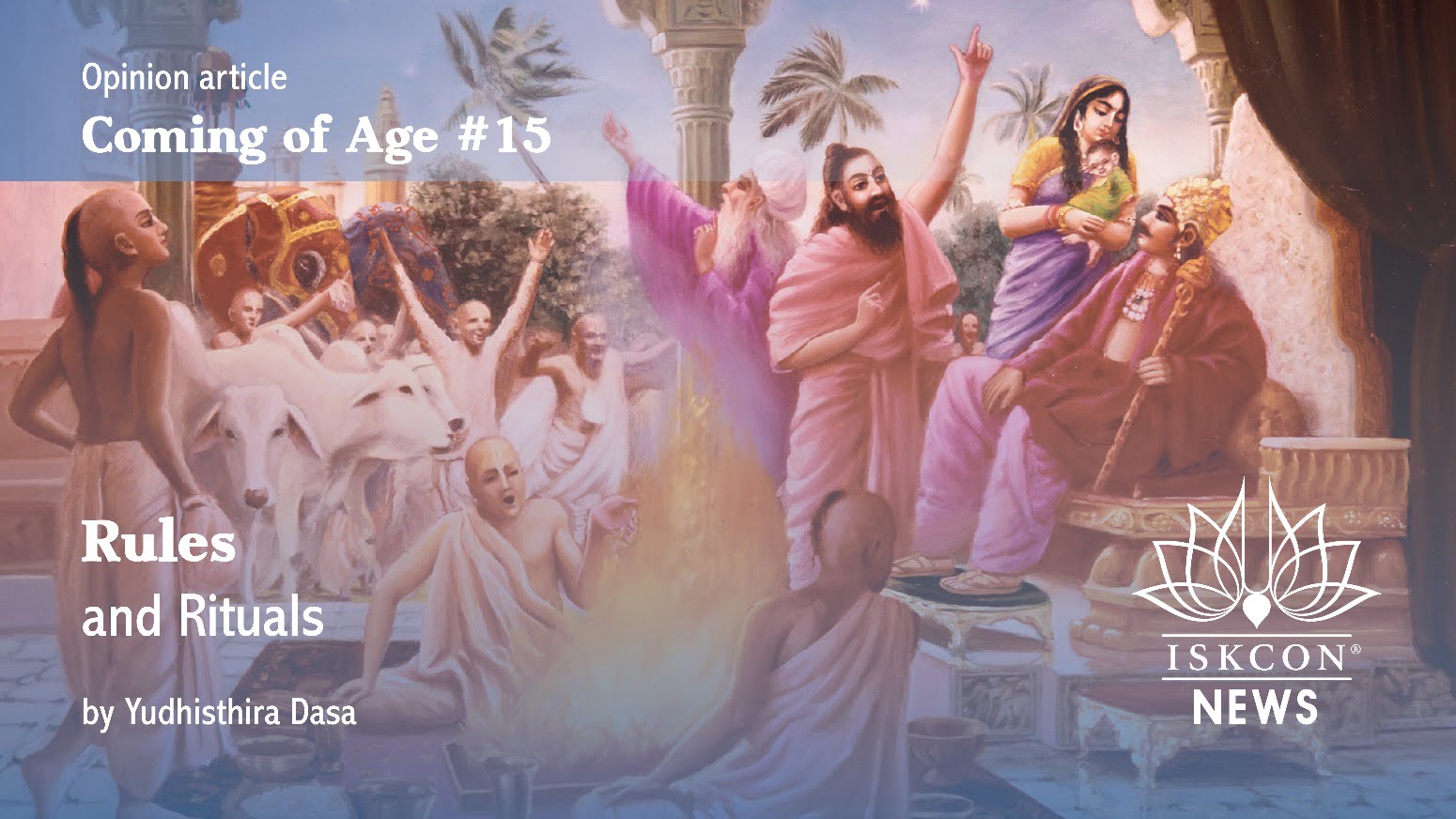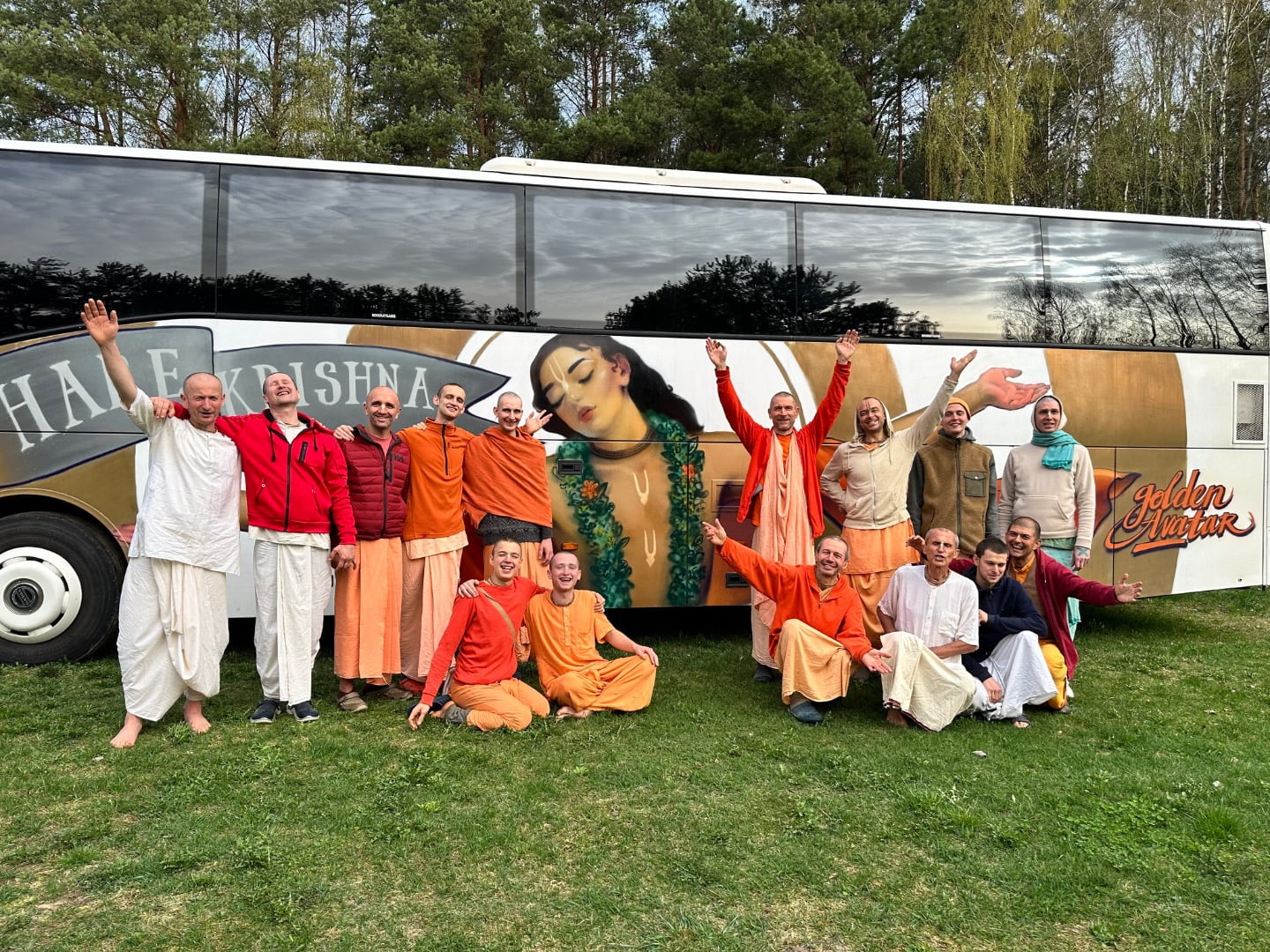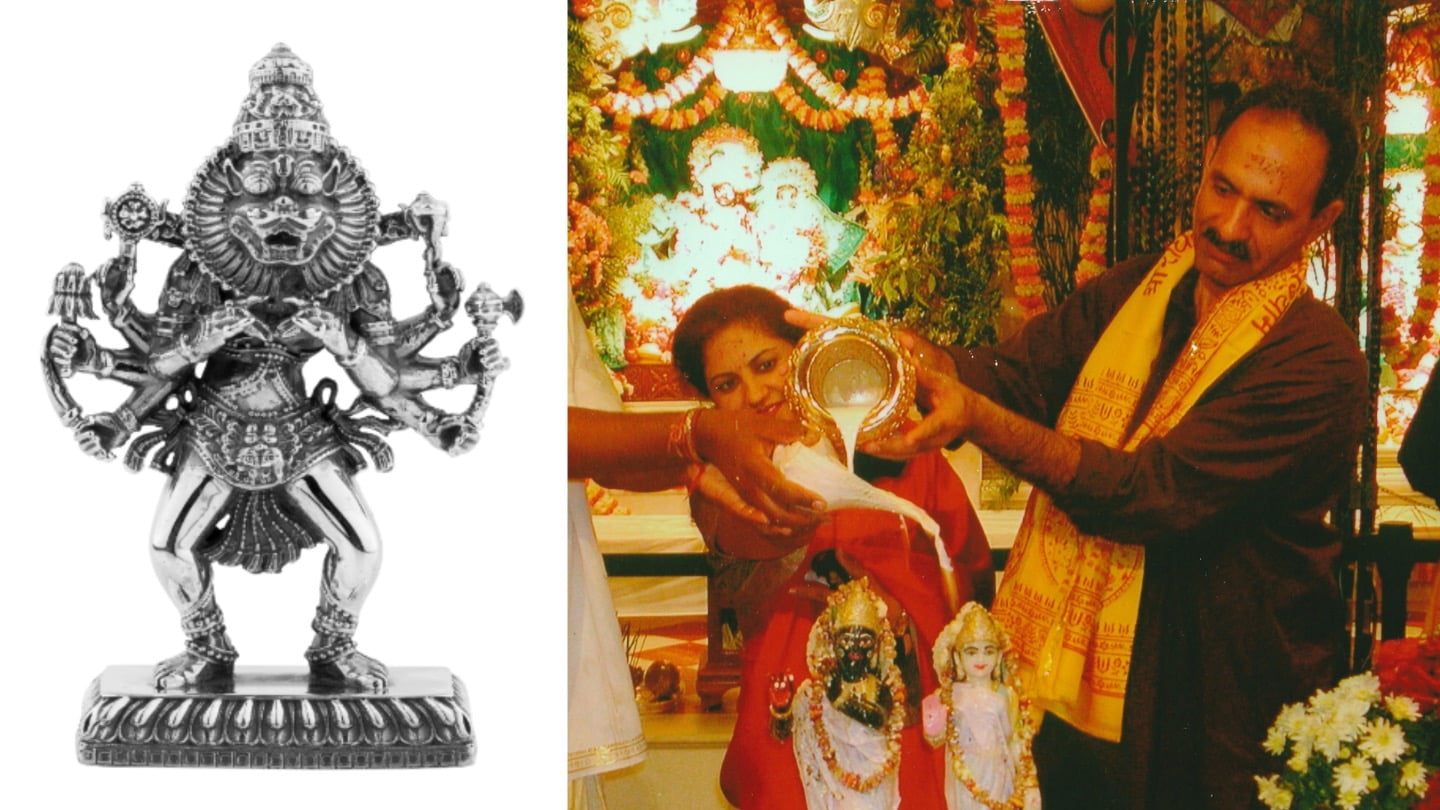Bhaktimarga Swami: A Life Dramatic
By Madhava Smullen | Jan 26, 2013

To ISKCON devotees everywhere, the name Bhaktimarga Swami conjures up images of powerful, out-of-the-box stage productions; and of energetic kirtans, full of stomping dance moves and jubilant smiles.
But a lifetime ago, as the boy John Vis growing up in rural Canada, he was a shy, retiring child.
“If I had gotten the chance to be on stage, I would have definitely frozen up,” he says. “But in my one room schoolhouse near Chatham, Ontario, I didn’t even get the opportunity—drama wasn’t part of the curriculum. Later, in highschool, I was supposed to play the role of a prince in a drama, but I shyed out of the whole thing!”
John did, however, pursue an interest in painting and sculpture, taking a Fine Arts course in college in Toronto. He created abstract art, including an anatomical piece so huge “you couldn’t fit it through the door,’ inspired by his favorite sculptor Henry Moore.
In 1973, after meeting ISKCON devotees on his college campus, John decided his artwork should have a clearer purpose. He began to paint Radha and Krishna and other spiritual subjects—one piece was a large rendition of ISKCON Founder Srila Prabhupada’s face.
Then, in March of that year, with only one month left of his Fine Arts course, John quit to join ISKCON full-time and was given the name Bhaktimarga, meaning Path of Devotion.
“I had to be a devotee, to live the life of a monk, even if it meant turning my back on all my work,” he says. “Maybe it was impulsive, but I just felt that was what I had to do at the time. The calling was too great.”
It was in those early days in ISKCON that Bhaktimarga began to develop the confidence and extrovert personality he is now known for.
“The first day I joined I was out on the street, meeting strangers through book distribution,” he recalls. “I also got over my shyness by having confidence in Krishna consciousness. It gives you so much inner strength.”
For the first few years, Bhaktimarga Swami’s main outlet for artistic expression was kirtan. But he also hugely enjoyed devotees’ production of The Pandavas Retire Timely at the Henry Street temple in New York—“they made the pages of the Bhagavatam jump onto the stage.”

A Scene from Bhaktimarga Swami’s play “Lonely People”
In 1975, he sat in an audience with Srila Prabhupada while watching The Chand Kazi Meets Chaitanya Mahaprabhu in Atlanta, Georgia, and was inspired by how much his guru appreciated the play.
“I spent half the time looking at the play, and the other half looking at Srila Prabhupada,” he says. “I could see how much he enjoyed dramas.”
Then, in Toronto in 1976, Bhaktimarga was invited by Bhakti Bringa Govinda Swami to portray the Vaishnava saint Sanatan Goswami in “The Touchstone.” The play—his first ever—featured Trilokanath Das as the materialist searching for happiness in the wrong places, and BB Govinda Swami as a cackling witch.
Inspired, and seeing a lack of enlightening entertainment in the world, Bhaktimarga Swami began to put on dramas at every major festival in Toronto, which was to become his home base up to this day.
In 1985, when he became temple president, he would put on plays at every North American Leaders’ Meeting he was called to attend. The other presidents loved it, and the practice became a habit that he’s stuck to ever since.
Today, Bhaktimarga Swami is one of ISKCON’s most renowned producers of Krishna conscious plays. He has directed ISKCON classics such as “The Boatman,” “Big Fish, Little Fish,” and the “Age of Kali.” And he has written and directed his own productions such as “Brother I Need You,” “Krishna: The Eighth Boy,” “Gods and Demons,” “Kunti and Karna,” and “Jagannath.”

A Scene from “Krishna: The Eighth Boy”
As well as portraying Krishna’s pastimes and presenting traditional philosophy in his plays, he likes his productions to comment on important ISKCON issues.
“For instance, I like to say something positive about wholesome family life,” he says. “And two years ago, I did a contemporary play called Lonely People, about a social issue that haunts many people including devotees. I was hearing reports that some devotees are lonely, or not feeling cared for. So I thought it was a gripping topic to explore, and offer a solution to at the end.”
Inspired by Srila Prabhupada’s instructions to focus on substance rather than getting distracted by over-elaborate scenery and costumes, his plays convey spiritual emotion and deep philosophical points in an instantly recognizable minimalist style.
Of course, that doesn’t mean he doesn’t know how to use costumes and props to great effect—his more recent Three Lives of Bharat delighted audiences with Lion King-style life-size puppets that moved with striking realism. And over the years, he has amassed quite the collection of costumes and props, kept under lock and key at ISKCON Toronto.
More importantly, however, Bhaktimarga Swami has built up a steady core group of young actors. He also has actors he can count on in various countries throughout the world.
For the past fourteen years, he has performed dramas at the Durban Rathayatra festival in South Africa, to an audience of over 3,000. He has also performed annually at Buenos Aires Rathayatra in Argentina, at the Festival of Inspiration in New Vrindaban, West Virginia, and at the Gaura Purnima festival in Mayapur, West Bengal, for many years.

Lord Krishna appears to his boy devotee in “Dhruva: The Prince of Anger and Peace.”
In Mayapur, he usually performs two dramas on two different occasions—one for the local devotees and GBC members meeting there at that time of year, and one for a one-thousand-strong international crowd.
Sometimes putting on these plays present challenges unique to ISKCON.
“Often, because the audience is very deep, I’ll vocalize for the actors from offstage, which makes things more technically safe and allows them to be more expressive in their movements,” Bhaktimarga says. “It’s a slightly more abstract take on things, but also closer to the traditional style of performance in India, where dancers portray the actions and singers tell the tale.”
Another common challenge for Bhaktimarga Swami is time.
“Often I’ve only got three or four days to put a whole production together,” he says.
But he likes the fun and immediacy of the experience, and says it’s a practical method for the volunteers who assist him.
Another major venue for his plays is ISKCON Youth Ministry’s Krishna Culture summer bus tour in the US, which he’s traveled with eight times.

A scene from Three Lives of Bharat
“I always like working with young people—when you’re in their midst, there’s always hope,” he says.
On the bus tour, plays are performed as part of a cultural presentation at theaters across the country. Each play engages thirty to forty youth, each in their own field of interest—acting, dance, music, making props, looking after costumes, make-up, lighting, sound and more.
“They get to have fun in Krishna consciousness, dovetail their youthful inclination to flaunt a little bit, and be educated at the same time,” Bhaktimarga says.
For the youth, doing plays are often amongst their best memories.
“A lot of our kids tell me, ‘The best part of my life was when I did a play at our temple,’” Bhaktimarga Swami recalls. “They say, ‘I’ll never forget the experience. Or the story.’”
Performing and producing dramas can be a powerful way to imbibe Krishna conscious stories and teachings. Actors often tell Bhaktimarga Swami that they didn’t pick up on a certain part of a story when they read it, but performing it made it really stick with them.
Similarly, actors often have deep Krishna conscious experiences by “becoming” a character, such as a great saint, when portraying them on stage, and thus more deeply understanding their motivations.
Bhaktimarga Swami reminds us of lawyer Atticus Finch’s famous instruction to his daughter Scout in the great American novel To Kill A Mockingbird: “You never really understand a person until you consider things from his point of view—until you climb into his skin and walk around in it.”

“Three Lives of Bharat” utilized Lion King-style life-size puppets
Audiences also gain much from watching devotional plays, a uniquely powerful way to teach Krishna consciousness.
“Most people are not so keen to read books or go into a temple,” Bhaktimarga Swami says. “But everybody loves to be entertained. So if we can take our message and present it on stage in a nice colorful way, then I think we’re really accomplishing something.”
Most recently, Bhaktimarga Swami has been working on two brand new productions. One is “Dhruva: The Prince of Anger and Peace.” Telling the story of the boy devotee from the Srimad Bhagavatam, it explores issues, such as how to deal with anger, that everyone can relate to.
Then there’s Gita Concise, which was previewed at the North American Leaders’ Meetings in Houston, Texas, this January. In this piece, Bhaktimarga Swami takes the famous philosophical dialogue of the Bhagavad-gita—the “Hindu Bible”—and matches it with powerful imagery that entertains and educates.
For instance, when Krishna talks about “One who is able to withdraw his senses from sense objects, as the tortoise draws its limbs within the shell,” we see an actor portray the tortoise.
And when Arjuna says to Krishna, “The mind is restless, turbulent, obstinate and very strong, O Krishna, and to subdue it, I think, is more difficult than controlling the wind,” we see an actor dressed in black and covered in Hawaiin grass skirts whirl and dance about the stage.
The play has been praised by ISKCON leaders, and by businessmen—one of whom commented that he planned to take his business partners to see it so they could better understand the Indian holy book. Bhaktimarga Swami plans to take the play around North America and abroad.
In the future, he hopes to keep producing Krishna conscious plays and thus inspire devotee youth to take them to the next level. He would like to see the treasure of the Vedic scriptures replace “the same old hackneyed, raunchy subject matter” of the modern theater scene.
“I’d like to see really top-notch devotional work being presented onstage,” he says. “I think we should get to the level of Cirque De Soleil. Get serious about it. Do it in a way we can be extremely proud of. And take it to the world.”
He’d also like to see the blossoming of his VANDE creative arts initiative, which supports ISKCON artists; and in the future, a Krishna conscious college for the creative arts.
“Until then, I’ll continue doing my dramas,” he says, “Because they give me life.”














